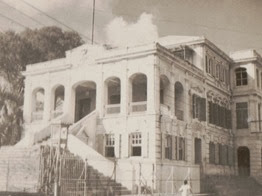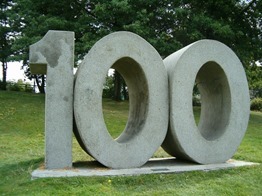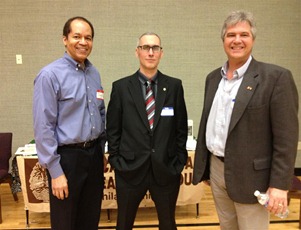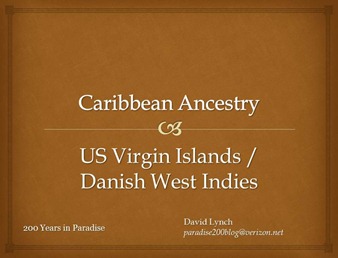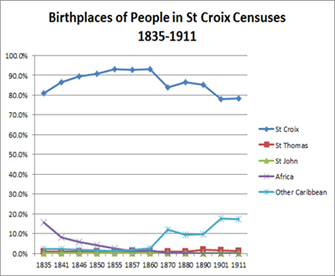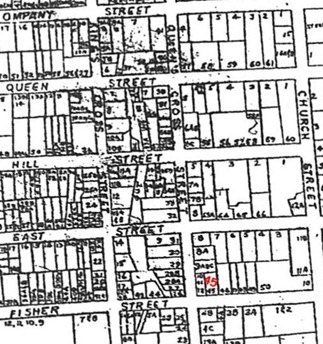
So far I have been a strictly paper genealogist. I have diligently traced my family line, backward, from myself to my 7th great grandparents on St Thomas. Throughout my journey I have uncovered a lot of history and learned that I really had no idea where I came from. It seems that every new record brought a new revelation about my heritage.
Of course, all of this work is but a quarter of my family tree. My Virgin Islands family is the family of my maternal grandfather, Ludvig Randolph Conrad. His wife, Olga LaGonterie, was from St Lucia. I have cousins who have been diligently researching this line of the family. My paternal line is of European descent by way of St Louis, Missouri. I’m researching them too, but it’s a much slower process (VI research is actually a lot easier than US research. I doubt there is a better recorded area).
While there are still many records I need to find, I decided I wanted to get into the fascinating world of genetic genealogy. DNA tests are somewhat expensive so I put it off for some time. This past December,
23andme lowered their prices to $99 and I couldn’t resist any longer. I took the test, sent it in, and just got my results this week. All in all, pretty consistent with my paper research. Guess none of us were adopted!
23andme does both health screening and ancestry analysis. Due to the fact that they screen for genetic predisposition to certain illnesses, you can’t order tests from Maryland or New York. I ordered it from my “Virginia address” and had no difficulties. The process took about 7 weeks from my order to my results.
The 23andme offer is actually quite cost-effective. From what I can tell, they do 3 tests (for men) for the same $99. These are the Y-chromosome test (Y-DNA) for men only, women don’t have Y-chromosomes, the mitochondrial DNA (mtDNA), which is passed mother to child, and the autosomal DNA. Using the Y-DNA and mtDNA, geneticists have separated populations into distinct groups of common, or near common ancestry. The groupings they find, called
haplogroups, can be localized to certain geographic regions. The understanding is that by knowing where a haplogroup is located one can tell where someone’s ancestors came from. This can go back thousands of years.
Y-DNA Test
Men have two sex chromosomes, an X from their mother and a Y from their father. The Y chromosome typically passes down father to son along with the surname in Western cultures. The haplogroup found in Y-DNA tells only about the single string of male ancestors. For me, this would be my father’s father’s father’s side. Paper research says that my father’s father’s father was from Ireland. The Y-DNA test bears this out. Although it can’t specifically trace to Ireland, it does trace to Western Europe. The specific haplogroup is R1b1b2a1a1d*. Given the migrations of people throughout Europe, I’m not surprised it can’t do better.
Here is the map on the 23andme site showing concentrations of haplogroup R1b1b2:

From this map, you can see the high concentration throughout the UK and Ireland, Germany, France, and Spain. For my specific group, 23andme says that it is most commonly found on the fringes of the North Sea.
Eupedia says that in Ireland, over 80% of the population are R1b.
mtDNA Test
Women don’t have Y-chromosomes, so they can’t pass them along. Instead, women pass along mtDNA from mother to daughter. Sons receive the mtDNA, but can’t pass it along. For this reason, mtDNA can tell the same thing about the female ancestry line that Y-DNA can tell about the male. It, too, is organized into haplogroups. In my case, my mother’s mother was from St Lucia. The mtDNA can tell me where her people came from long before they took up residence in Vieux Fort.
According to 23and me, my maternal haplogroup is L3e2a. Here is the concentrations of that haplogroup:

As a reference, 23andme says the a typical Nigerian person is group L3e2b2. Very close. Wikipedia’s article on
Haplogroup L3 (mtDNA) says that L3e is the most common L3 group in the Caribbean. Since the Atlantic slave trade drew most heavily from the western sub Saharan region (the slave coast), this isn’t surprising.
Other Tests

In addition, 23andme does family matching, which is probably autosomal DNA. They look through their database and tell you the closest matches to your DNA, looking for cousins. Sadly, I don’t have very many matches. Of the matches they found (3rd to 6th cousins), the closest are from the paternal line. This is probably because few Caribbean descendants have had their DNA tested.
23andme lowered their prices to encourage more testing to grow their database. Eventually, when more people take advantage of the testing, I hope to find some closer relatives.
Next Steps
The most popular site for genetic genealogy is Family Tree DNA (FTDNA). They supposedly have the largest database and are geared more toward genealogy rather than health issues. Their Family Finder test, which is similar to the 23andme costs $289. However, I can upload my test results from 23and me and for only $89 I can get the analysis and database of FTDNA (they use the same detection tools). By doing the 23andme and uploading it to FTDNA, I can get in both systems for only $189. Much better deal than $289 for just one!
There’s a lot more to learn about genetic genealogy, I’m just beginning.
Another step I need to take is to talk some of my new-found cousins into getting tested. Since my VI ancestry passes through both men and women, neither the Y-DNA nor the mtDNA takes me back to the VI. I do, however, have a distant cousin on St Thomas (you know who you are), who carries on the family name that first appeared in St Thomas in 1690. Perhaps I can talk him into getting a 23andme test so we can see where the van Beverhoudts came from! I would be very interested in that!
If you’re from the VI, get tested and get into the databases. Since we all seem to be related and I can’t seem to find a relative, you must not be in there yet. Or at least, not in 23andme.


